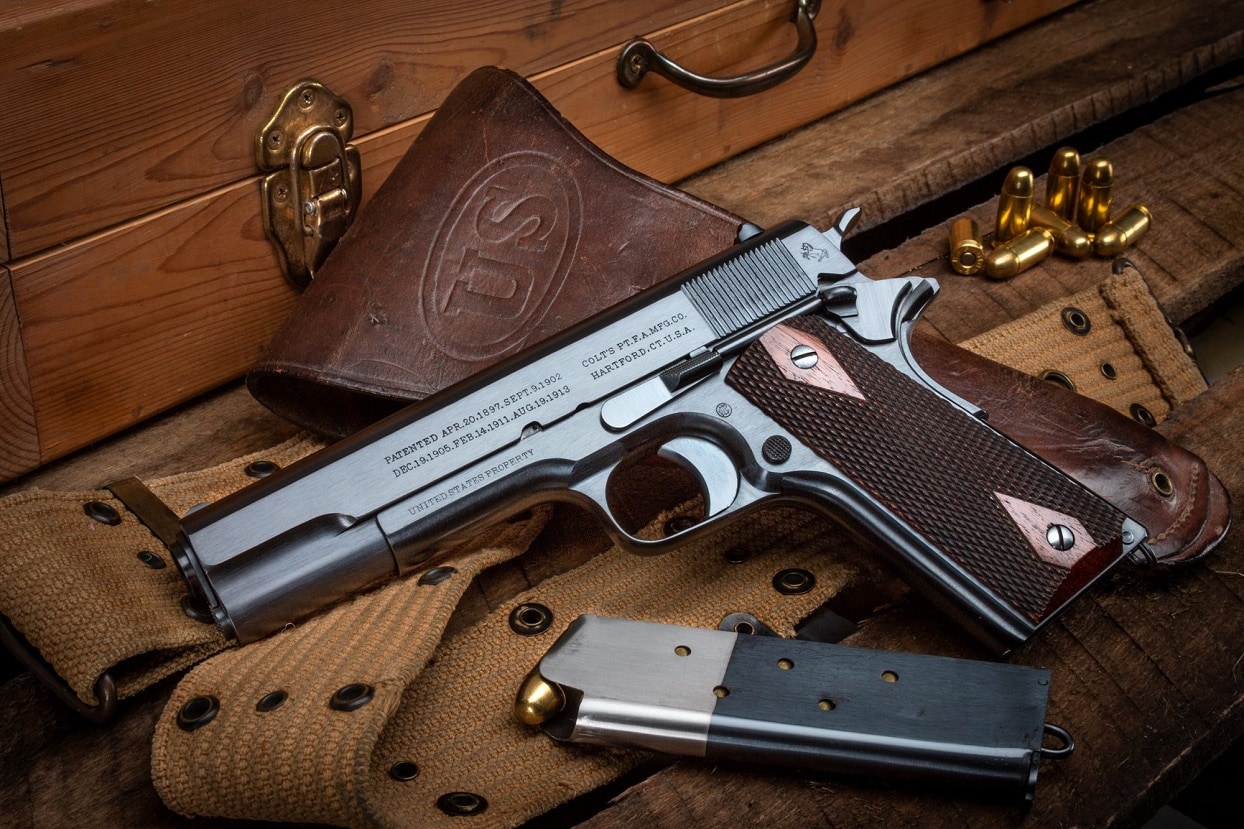They loved it in the military and they love it as civilians. The Colt M1911 is still a fan favorite after over 100 years since its inception. It has a simple design and it’s easy to use. It’s popular for self-defense and as a collector’s keepsake. Many gun enthusiasts have one to commemorate its use in a number of U.S. wars. Military personnel and law enforcement like the stopping power of the .45 ACP round. The pistol is fairly easy to conceal and simple to disassemble and reassemble. The Colt M1911 overall is just a beloved gun.
Check a veteran’s magazine from the American Legion or the Veterans of Foreign Wars. You’ll often find an ad for a silver-plated Colt M1911 edition with inscriptions from all the wars it was used in. The price is usually reasonable. Then visit a gun store or show and you will see all the variants and manufacturers that have some form of the Colt M1911 for sale.
The M1911 Has a Long and Interesting History
The Colt M1911 has enjoyed a colorful history. The U.S. military used revolvers in the 1890s that were cumbersome and slow to re-load. The main conflict at that time was the Philippines insurrection that lasted from 1899 to 1902. The troops yearned for a sidearm that was semi-automatic and could penetrate jungle foliage against the insurgents. These Moro militants in the Philippines could often survive several revolver rounds before they stopped fighting. The Army wanted a quick-loading .45 caliber bullet to better protect the troops in close-quarter combat.
Several manufacturers sent in a bid in 1907 and the Army eventually picked the Colt because it rarely malfunctioned. Other branches of the military began using it after 1911 and it really passed the battlefield test during World War One. Thousands were produced by various makers. Then during World War Two the military ordered nearly two million. The overall design stayed the same and parts were interchangeable. U.S. allies such as the British started using it to rave reviews.
Service in More Wars Than You Know
It was adopted even more during the wars in Korea and Vietnam. One of the only complaints was that soldiers and marines were shooting themselves while cleaning the pistol in Vietnam. Maintenance of the pistol was paramount in the humid jungles of Southeast Asia. It was determined that personnel were forgetting to unload the Colt before cleaning!
The Colt M1911 remained in service until 1985 when its was replaced by the M9 Beretta. The critiques on the Beretta started pouring in. Mainly personnel didn’t like the 9mm bullet and felt the .45 ACP was better if a war happened with the Soviet Union. Special Operations Forces, who often have more latitude in weapons choices, still preferred using the M1911 to this day.
Colt M1911: How Does It Perform?
The ergonomics of the Colt M1911 make for comfortable shooting. The grip has a nice angle for a relaxed press of the trigger with a decent amount of recoil. It weighs 39 ounces (more than the Beretta M9) and with a five-inch barrel, it’s fairly easy to conceal since the gun is not very thick. However, the magazine is usually only seven or eight rounds (fewer than the Beretta) and the effective range is 50 meters.
The Colt usually costs at least $500 depending on the manufacturer and the ability to add accessories and the type of sights. Stainless steel models cost more. Better-known gun makers such as Springfield Armory, Remington, and Ruger have a higher price tag.
The Colt M1911 is a testament to designer John Browning’s original vision for the pistol. He would never have guessed that the original design of the gun would stay the same for 110 years. Military veterans came back from wars with a nostalgia for the Colt. Numerous armies from around the globe have it in their arsenal. Collectors love its history. Property owners use it for home defense. Law enforcement personnel like its concealability. Target shooters love its action and accuracy. The M1911 will enjoy popularity for years to come.
1945’s new Defense and National Security Editor, Brent M. Eastwood, PhD, is the author of Humans, Machines, and Data: Future Trends in Warfare. He is an Emerging Threats expert and former U.S. Army Infantry officer.

